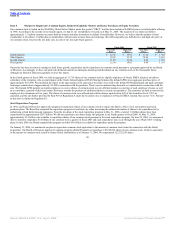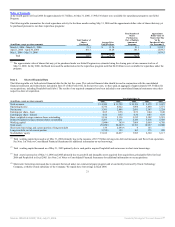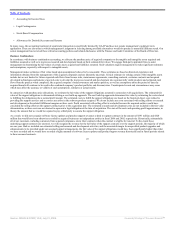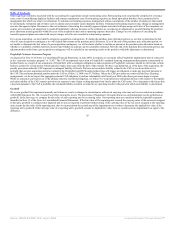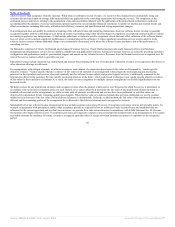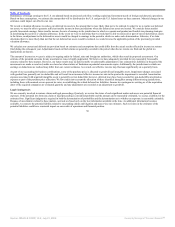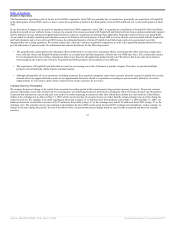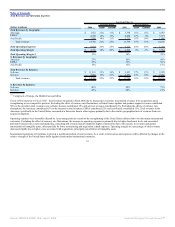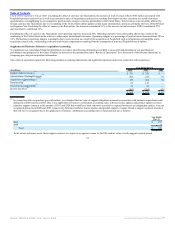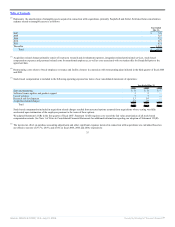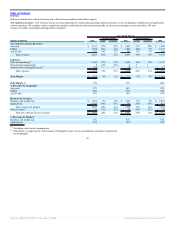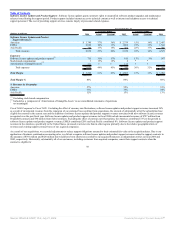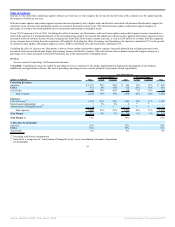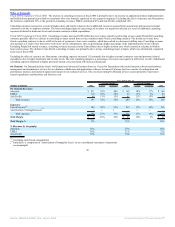Oracle 2005 Annual Report Download - page 33
Download and view the complete annual report
Please find page 33 of the 2005 Oracle annual report below. You can navigate through the pages in the report by either clicking on the pages listed below, or by using the keyword search tool below to find specific information within the annual report.
Table of Contents
Remittances of foreign earnings to the U.S. are planned based on projected cash flow, working capital and investment needs of foreign and domestic operations.
Based on these assumptions, we estimate the amount that will be distributed to the U.S. and provide U.S. federal taxes on these amounts. Material changes in our
estimates could impact our effective tax rate.
We record a valuation allowance to reduce our deferred tax assets to the amount that is more likely than not to be realized. In order for us to realize our deferred
tax assets, we must be able to generate sufficient taxable income in those jurisdictions where the deferred tax assets are located. We consider future market
growth, forecasted earnings, future taxable income, the mix of earnings in the jurisdictions in which we operate and prudent and feasible tax planning strategies
in determining the need for a valuation allowance. In the event we were to determine that we would not be able to realize all or part of our net deferred tax assets
in the future, an adjustment to the deferred tax assets would be charged to earnings in the period in which we make such determination. Likewise, if we later
determine that it is more likely than not that the net deferred tax assets would be realized, we would reverse the applicable portion of the previously provided
valuation allowance.
We calculate our current and deferred tax provision based on estimates and assumptions that could differ from the actual results reflected in income tax returns
filed during the subsequent year. Adjustments based on filed returns are generally recorded in the period when the tax returns are filed and the global tax
implications are known.
The amount of income tax we pay is subject to ongoing audits by federal, state and foreign tax authorities, which often result in proposed assessments. Our
estimate of the potential outcome for any uncertain tax issue is highly judgmental. We believe we have adequately provided for any reasonably foreseeable
outcome related to these matters. However, our future results may include favorable or unfavorable adjustments to our estimated tax liabilities in the period the
assessments are made or resolved, audits are closed or when statutes of limitation on potential assessments expire. Additionally, the jurisdictions in which our
earnings or deductions are realized may differ from our current estimates. As a result, our effective tax rate may fluctuate significantly on a quarterly basis.
As part of our accounting for business combinations, some of the purchase price is allocated to goodwill and intangible assets. Impairment charges associated
with goodwill are generally not tax deductible and will result in an increased effective income tax rate in the quarter the impairment is recorded. Amortization
expense associated with acquired intangible assets is generally not tax deductible; however, deferred taxes have been recorded for non-deductible amortization
expense as part of the purchase price allocation. We have taken into account the allocation of these identified intangibles among different taxing jurisdictions,
including those with nominal or zero percent tax rates, in establishing the related deferred tax liabilities. Income tax contingencies existing as of the acquisition
dates of the acquired companies are evaluated quarterly and any adjustments are recorded as an adjustment to goodwill.
Legal Contingencies
We are currently involved in various claims and legal proceedings. Quarterly, we review the status of each significant matter and assess our potential financial
exposure. If the potential loss from any claim or legal proceeding is considered probable and the amount can be reasonably estimated, we accrue a liability for the
estimated loss. Significant judgment is required in both the determination of probability and the determination as to whether an exposure is reasonably estimable.
Because of uncertainties related to these matters, accruals are based only on the best information available at the time. As additional information becomes
available, we reassess the potential liability related to our pending claims and litigation and may revise our estimates. Such revisions in the estimates of the
potential liabilities could have a material impact on our results of operations and financial position.
30
Source: ORACLE CORP, 10-K, July 21, 2006 Powered by Morningstar® Document Research℠


